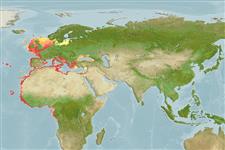Elasmobranchi (squali e razze) (sharks and rays) >
Myliobatiformes (Stingrays) >
Dasyatidae (Stingrays) > Dasyatinae
Etymology: Dasyatis: Greek, dasys = rough, dense (Ref. 45335).
More on author: Linnaeus.
Environment: milieu / climate zone / distribuzione batimetrica / distribution range
Ecologia
marino; salmastro demersale; distribuzione batimetrica 5 - 200 m (Ref. 6808), usually 20 - 35 m (Ref. 27000). Subtropical; 61°N - 17°S, 32°W - 42°E
East Atlantic and the Mediterranean and Black Sea, from the North Sea to Angola.
Length at first maturity / Size / Peso / Age
Maturità: Lm 54.3, range 41 - ? cm
Max length : 69.5 cm WD maschio/sesso non determinato; (Ref. 123699); peso massimo pubblicato: 14.6 kg (Ref. 86713)
A coastal species, which enters coastal lagoons, shallow bays and estuaries (Ref. 81259). Found over sandy and muddy bottoms, sometimes near rocky reefs (Ref. 12951). Feeds on bottom fishes, crustaceans and mollusks. Ovoviviparous, gestation period about 4 months and 4-7 young are produced. Wings marketed smoked, dried-salted, and also used for fishmeal and oil. Harmful to shellfish banks; dangerous to bathers and fishers due to its poisonous spine. Barbed poison spine is a modified denticle that can be 35cm long, shed occasionally and replaced (Ref. 35388). Maximum reported width about 150 cm (Ref. 81259).
Exhibit ovoviparity (aplacental viviparity), with embryos feeding initially on yolk, then receiving additional nourishment from the mother by indirect absorption of uterine fluid enriched with mucus, fat or protein through specialised structures (Ref. 50449). Distinct pairing with embrace (Ref. 205).
Bauchot, M.-L., 1987. Raies et autres batoides. p. 845-886. In W. Fischer, M.L. Bauchot and M. Schneider (eds.) Fiches FAO d'identificationpour les besoins de la pêche. (rev. 1). Mèditerranée et mer Noire. Zone de pêche 37. Vol. II. Commission des Communautés Européennes and FAO, Rome. (Ref. 3261)
IUCN Red List Status (Ref. 130435: Version 2025-1)
Human uses
Pesca: commerciale; Pesce da pesca sportiva: si
Strumenti
Special reports
Download XML
Fonti Internet
Estimates based on models
Preferred temperature (Fonte Biblio.
123201): 9.7 - 26.1, mean 12.2 °C (based on 352 cells).
Phylogenetic diversity index (Fonte Biblio.
82804): PD
50 = 0.5020 [Uniqueness, from 0.5 = low to 2.0 = high].
Bayesian length-weight: a=0.00389 (0.00302 - 0.00501), b=3.10 (3.03 - 3.17), in cm total length, based on LWR estimates for this species (Ref.
93245).
Trophic level (Fonte Biblio.
69278): 3.6 ±0.5 se; based on diet studies.
Resilienza (Fonte Biblio.
120179): Molto basso, tempo minimo di raddoppiamento della popolazione più di 14 anni (Fec=4-7).
Fishing Vulnerability (Ref.
59153): Very high vulnerability (78 of 100).
🛈
Climate Vulnerability (Ref.
125649): Moderate to high vulnerability (55 of 100).
🛈
Nutrients (Ref.
124155): Calcium = 14.1 [1.7, 252.0] mg/100g; Iron = 0.696 [0.063, 8.002] mg/100g; Protein = 21.3 [18.7, 24.0] %; Omega3 = 0.263 [0.085, 0.750] g/100g; Selenium = 22 [4, 104] μg/100g; VitaminA = 7.14 [0.64, 75.50] μg/100g; Zinc = 0.591 [0.039, 6.718] mg/100g (wet weight);
